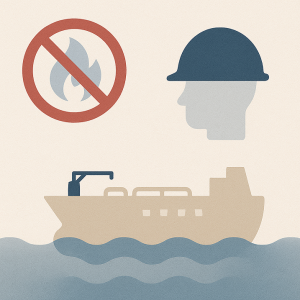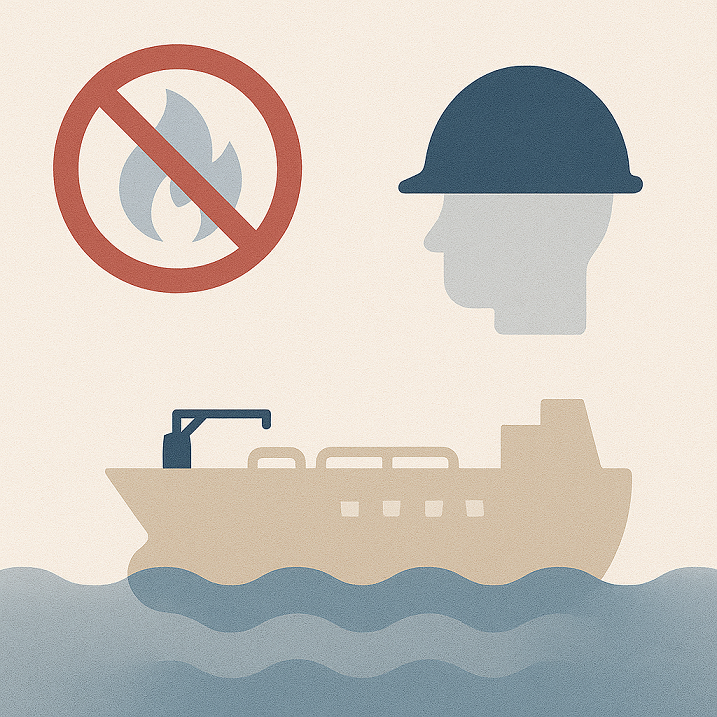Explore the top 12 safety precautions when handling the Inert Gas System (IGS) on ships. Learn best practices, real-world examples, and expert guidance in this essential guide for maritime professionals.

Why Inert Gas Systems Matter in Modern Maritime Operations
When transporting flammable cargoes such as crude oil or refined petroleum products, safety is not optional—it’s a matter of life and death. This is where the Inert Gas System (IGS) steps in. Designed to reduce oxygen levels in cargo tanks, IGS prevents explosions by replacing oxygen-rich air with a non-flammable mixture, typically derived from exhaust gases or gas generators.
According to the International Maritime Organization (IMO), over 90% of tankers above 20,000 DWT are equipped with some form of IGS [IMO, 2023]. However, despite its role in enhancing ship safety, the system comes with operational risks if mishandled—including backflow, corrosion, gas leaks, and system failure. Therefore, rigorous safety protocols are essential.
Understanding the Inert Gas System: An Overview
The IGS consists of several major components: an inert gas generator or exhaust uptake system, scrubber tower, demister, blower unit, deck water seal, non-return valves, pressure regulating valves, and distribution piping. It operates by injecting inert gas into cargo tanks, reducing oxygen concentration below 8%, the critical threshold for hydrocarbon combustion.
Recent reports from the Marine Accident Investigation Branch (MAIB) and classification societies such as DNV and Lloyd’s Register have underlined the dangers posed by improper IGS operation, citing incidents where explosions occurred due to oxygen levels exceeding 10%.
Key Safety Technologies and Developments in IGS Operation
Technological advances have improved IGS reliability, including:
- Automated oxygen analyzers with fail-safes and alarms.
- Digital twin systems for IGS monitoring (Wärtsilä, 2022).
- Real-time control from bridge or ECR.
- Self-cleaning demisters and corrosion-resistant coatings in scrubber units.
Yet, even with these innovations, human vigilance remains the most vital safety barrier.
–
Top 12 Safety Precautions When Handling the IGS
Ensure Proper Training and Certification
Crew members responsible for IGS must be thoroughly trained under the Standards of Training, Certification and Watchkeeping (STCW) Code. Familiarity with IMO guidelines (MSC/Circ.585) and manufacturer-specific manuals is essential. Regular onboard drills should include inert gas system scenarios.
Pre-Start System Checks and Inspections
Before starting the system, inspect for:
- Leaks in piping or seals
- Proper function of valves, fans, and alarms
- Scrubber water levels and demister integrity
Use a pre-start checklist as advised by ClassNK and ABS. Missing even one component could result in system malfunction or dangerous gas ingress.
Maintain the Deck Water Seal
The deck seal prevents backflow of gas from the cargo tanks to the engine room. Any malfunction here can lead to catastrophic fire or explosion. Ensure the water level is correct, overflow pipes are clear, and heaters (in cold climates) are operational.
Monitor Oxygen and Pressure Levels Continuously
Oxygen concentration should never exceed 8% in the tanks during inerting. Use dual oxygen analyzers with alarm redundancy. Simultaneously, ensure positive tank pressure (typically 200-300 mmWG) to avoid air ingress.
Use Personal Protective Equipment (PPE)
Despite being ‘inert’, the gas may contain carbon monoxide or SOx/NOx residues from combustion. Proper PPE including gas masks, goggles, and flame-retardant clothing must be worn during inspection or repair operations.
Prevent Over-Pressurisation of Cargo Tanks
Excess pressure can damage tank structure. Operators must ensure pressure relief valves are functional and avoid manual errors in valve settings. New IMO guidelines (MEPC.330(76), 2021) emphasize automated pressure regulation.
Avoid Moisture-Related Corrosion
Scrubber systems introduce moisture into inert gas. If demisters are faulty, water can enter the cargo tanks, leading to corrosion. Regular inspection and timely demister cleaning/replacement is key, as recommended in IACS UR F15.
Prevent Backflow of Hydrocarbon Vapors
Backflow may lead to engine room contamination or explosion. Always confirm operation of non-return valves and maintain pressure differential across the deck seal. During deballasting or tank venting, monitor pressure closely.
Isolate Electrical Systems Before Maintenance
Many IGS components are electrically driven. Before conducting maintenance, isolate electrical supply and apply lock-out/tag-out (LOTO) procedures. This is particularly vital when servicing blowers or control panels.
Ventilate Enclosed Spaces Before Entry
If entry into scrubber compartments or IGS pipelines is required, ensure ventilation with fresh air. Use portable gas detectors to verify oxygen levels and absence of toxic gases. Entry must follow IMO Resolution A.1050(27) on enclosed space entry procedures.
Log Operational Data and Maintenance Activities
Maintain a dedicated IGS logbook. Entries should include start/stop times, oxygen/pressure readings, maintenance actions, and abnormal observations. This documentation is often inspected during Port State Control checks and internal audits (ISPS/ISM).
Stay Updated on Safety Bulletins and Manufacturer Guidelines
Manufacturers like Alfa Laval and Wärtsilä regularly publish technical bulletins highlighting common faults and upgrades. Subscribing to these updates and incorporating them into your Safety Management System (SMS) ensures compliance with SOLAS Chapter II-2.
Case Study: The MT “Volgoneft” Incident
In 2020, the oil tanker MT Volgoneft-285 suffered an explosion while at anchor due to a backflow of hydrocarbon vapors into the IGS line. Investigation by the Russian Maritime Register of Shipping found that the deck seal water level had been below operational requirements, and non-return valves had corroded shut. The result was a flashback into the engine room, injuring two crew members. This incident underlines the importance of even the “smallest” component in the system.
Common Challenges and How to Overcome Them
Lack of IGS Familiarity Among Crew
Some junior officers and ratings may have limited exposure to IGS systems. Solution: Enhanced simulator-based training and mentorship from senior engineers.
Poor Maintenance Culture
Deferred maintenance on scrubbers, valves, or seals can lead to breakdowns. Adopt predictive maintenance using digital tools and adhere to class society maintenance intervals.
Ambiguity in System Layouts
Not all ships have identical IGS configurations. Use ship-specific training and encourage open communication between deck and engine departments.
Future Outlook: Smarter, Safer IGS Operations
The future lies in smarter systems that integrate with ship automation. Predictive analytics, IoT-based sensors, and AI-driven alerts are becoming mainstream. For example, MAN Energy Solutions and Honeywell are trialing AI-based IGS monitoring platforms that anticipate failures before they occur.
Moreover, IMO’s upcoming GHG reduction goals may see increased demand for clean-burning inert gas generators, moving away from traditional uptake-based systems.
Frequently Asked Questions (FAQ)
What is the minimum oxygen level in cargo tanks during inerting?
As per SOLAS and IMO guidelines, oxygen concentration should be kept below 8% by volume to prevent combustion.
Is inert gas flammable?
No, inert gas is non-flammable due to its low oxygen content. However, impurities like carbon monoxide can still be toxic.
How often should the deck seal be checked?
Daily visual checks are standard, with detailed monthly inspection as part of the Planned Maintenance System (PMS).
Can IGS be used during cargo operations?
Yes, IGS is typically used during discharging, crude oil washing, and tank cleaning to prevent vapor-air mixtures from forming.
What is the role of the demister?
It removes moisture from the gas after scrubbing. A faulty demister can lead to water ingress in tanks and corrosion issues.
Is training for IGS mandatory?
Yes. As per STCW Code and ISM Code, crew must be trained in safety-critical systems, including IGS.
Do all tankers have IGS?
Most tankers above 20,000 DWT are required to have IGS. Exceptions exist for certain chemical and product tankers under specific flag states.
Conclusion: Safety is Engineered, but Practiced by Humans
While the Inert Gas System is a marvel of marine engineering, it’s the seafarer’s knowledge, vigilance, and discipline that ensure its safe operation. Each valve turned and every pressure gauge checked plays a role in protecting lives, cargo, and the marine environment. As automation grows, the human element must not be overlooked.
Operators and shipping companies must continue investing in training, preventive maintenance, and updated technology to meet not just regulatory requirements but to foster a culture of safety at sea. After all, one small oversight in IGS operation can have explosive consequences.
References
- International Maritime Organization (IMO). (2023). SOLAS Consolidated Edition. https://www.imo.org
- DNV. (2022). Maritime Safety Updates. https://www.dnv.com
- Wärtsilä. (2022). Digital Twin for Marine Systems. https://www.wartsila.com
- ClassNK. (2021). Technical Circular on IGS Maintenance. https://www.classnk.or.jp
- MAIB. (2020). Marine Accident Reports. https://www.gov.uk/maib-reports
- IACS. (2021). Unified Requirements F15. https://www.iacs.org.uk
- Alfa Laval. (2023). Scrubber System Manuals. https://www.alfalaval.com
- BIMCO. (2023). Ship Safety Guidelines. https://www.bimco.org

